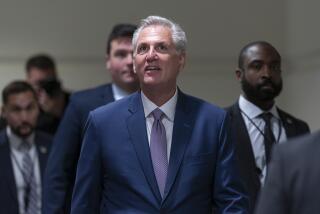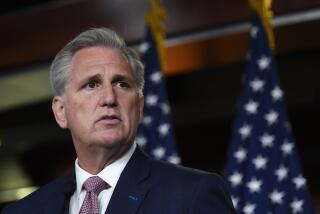House Panel Lowers Ceiling on RTC’s Borrowing by 75%
- Share via
WASHINGTON — A House banking subcommittee, expressing anger over the growing cost of thrift industry cleanup, voted Wednesday to provide only 25% of the $80 billion requested by the Bush Administration and called for a pay-as-you-go funding system for the rest of the job.
The vote would allow the Resolution Trust Corp., the agency overseeing the savings and loan rescue, to borrow an additional $20 billion. But more funds would have to come from an unlikely agreement between President Bush and Congress to raise taxes or cut spending in other federal programs.
The amendment, offered by Rep. Joseph P. Kennedy II, passed by a vote of 18 to 17 after a long and contentious debate in the financial institutions subcommittee of the House Banking Committee.
The subcommittee also approved another amendment by voice vote that would streamline the RTC by creating the position of chief executive. The new executive would be charged with day-to-day operating responsibility for the savings and loan bailout.
In the debate on funding, Kennedy said that by avoiding borrowing $60 billion through 30-year bonds, the nation could save $145 billion in interest costs and stop the “destructive practice of passing our bills along to our children and grandchildren.”
But opponents insisted that the amendment was a futile gesture, arguing that a Congress unable to pass a 5-cent increase in the gasoline tax during the summer is hardly likely to find a politically acceptable way to raise $60 billion. The committee’s ranking Republican, Rep. Chalmers Wylie of Ohio, said the amendment would “clog the process of providing funds” for the S&L; cleanup and warned that it would draw a certain Presidential veto if approved by the full Congress.
A similar amendment was approved by the House Banking Committee earlier this year but defeated in the full House as part of a funding bill for the thrift cleanup.
The RTC will have spent $80 billion by year-end to close more than 600 defunct thrifts and pay off depositors, whose accounts are insured up to $100,000. The Bush Administration says it needs $80 billion more and wants to raise the money through the sale of bonds. The total price tag, including interest payments, could reach $500 billion or more during the next 40 years.
The subcommittee members were clearly restive and agitated about the performance of the huge agency, which has a massive portfolio of more than $160 billion in securities, mortgages, loans and foreclosed real estate properties from failed thrifts.
The subcommittee approved an amendment offered by Rep. Frank Annunzio (D-Ill.), the subcommittee chairman, that would limit RTC’s borrowing ability to 85% of the value of the assets under its control. In addition to the $80 billion to cover direct losses at defunct S&Ls;, the RTC also seeks to borrow additional funds for temporary working capital. The Bush Administration has said all of this money can be repaid by the sale of assets.
However, Kennedy cited a Los Angeles Times study that disclosed that the RTC expects to recover only 60% of the original value of the assets under its control. The Times computer review of RTC records shows that the agency estimates that the assets will bring about $25 billion when they are sold--$15 billion less than the $40-billion values listed on the books of the failed S&Ls.;
The subcommittee also brushed aside Administration objections and voted for a new management structure for the RTC, with a powerful CEO nominated by the President and confirmed by the Senate. The RTC Oversight Board, now dominated by the Administration, would be stripped of many of its powers to interfere in the daily operations of the RTC.
More to Read
Get the L.A. Times Politics newsletter
Deeply reported insights into legislation, politics and policy from Sacramento, Washington and beyond. In your inbox twice per week.
You may occasionally receive promotional content from the Los Angeles Times.






